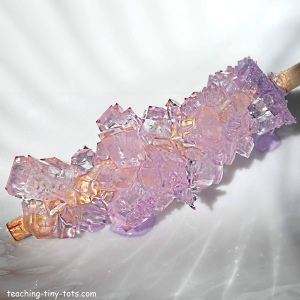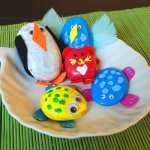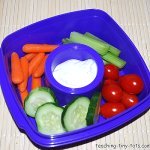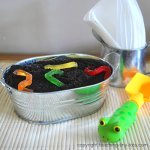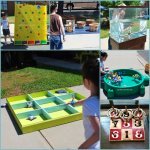- Home
- Science Activities
- Sugar Crystals
Making Sugar Crystals
A simple experiment to demonstrate how crystals grow using sugar and food coloring while also learning about solids and liquids. It will take time for your crystals to form but the result is worth waiting for! You can even eat the rock candy crystals once they have formed if you take measures to keep the solution free of particles or dust.
Description
Using just three ingredients, water, sugar and food coloring, create these really cool sugar crystals!Materials
1 cup water
2 - 2 1/2 cups sugar
Clear Jar or Cup (Be sure it is clean especially if it will be tasted, but also to keep the crystals from forming on the glass)
Assorted Food Coloring
1/4 inch dowel (we also tried string and a skewer)
Measuring Cup
Spoon
Small Pot
Coffee filter or paper towel to place on top of jar to keep the solution clean.
Steps
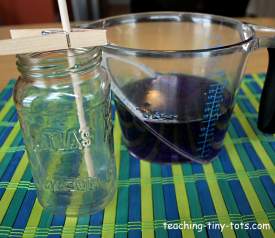
- Clip a thin wooden dowel with a clothespin.
- Place in jar so that the dowel is about an inch from the bottom and not touching the sides.
- Boil water. (Adult Step)
- Add 1/4 cup sugar and stir until completely dissolved. (Adult Step or supervision)
- Keep adding sugar in increments and stirring until it stops dissolving. We used 2 1/2 cups of sugar.
- Remove from heat and let cool for 10 minutes.
- Pour into a measuring cup. A clear measuring cup makes it easy for your child to view as you pour into the clear glass jar.
- Be sure to read our tips and info below for best results.
Tips and Suggestions
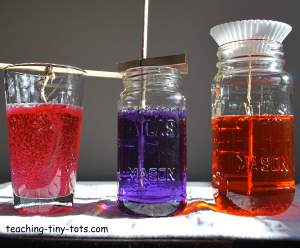
- We found the dowel worked the best. This can be found in the craft section or in a craft store.
- We found string to be the most difficult. The white kitchen string floated and the twine touched the glass which caused it to get stuck on the glass. I just read a tip where you can tie the kitchen string to a lifesaver to keep it from floating! If you are not eating it, a small paper clip will work too.
- If you want to use string, you may wish to grow a seed crystal to help promote growth of crystals. Saturate your string with a little of the syrup you just made and then dip the string in sugar. We omitted this step but it might be helpful for those using string.
- The crystals will be significantly lighter than the color of your water, notice the color of the mixture and the end result of the purple crystals above. On the other hand, if you put too much dye it is harder to see the crystals forming.
- Results will vary. Seeing the difference between the three samples indicates that success may vary with what type of container you use, whether you use a dowel or string. Temperature in your home may affect how quickly the crystals form as well.
- Be sure to let it cool slightly before pouring into glass jar. Do NOT ever completely seal a glass jar containing a very hot fluid. You can risk the jar bursting.
Other Ideas
Take pictures of each part of the experiment, mount on construction paper,
and have your child put the pictures in order. Make it into a book or use as sequencing cards. Ask your child what happened and write it under each photo.
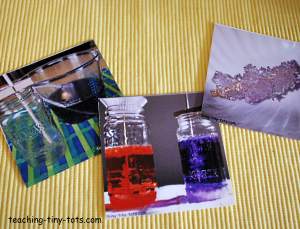
Educational Notes
How does this work?
The basic principle behind growing sugar crystals is to saturate the water with sugar to the point where the water can no longer contain all of the sugar molecules. While the water is hot, it can hold more molecules of sugar. When making a sugar solution designed to make crystals, by completely saturating the hot water with sugar until no more can dissolve, makes it possible for the crystals to grow when the water cools. As the water in the jar starts the evaporate, the sugar is extracted from the solution and forms sugar crystals on your skewer, dowel or string.
How Long Does It Take?
Even when the water has been completely saturated, it can take one to two of weeks until you get the results shown above. One of our slower growing crystals took 3 weeks.
Why do you use a string or dowel?
This gives the crystals something to form on and makes it easier to view.
Scientific Processes
Observation- Seeing Watching the crystals grow each day.
- Feelingthe crystals after they form
- Tasting if you let them taste the crystals...or the sugar before mixing into the water
- Silent Showing how the sugar is dissolved in the water.
- Oral Lots of verbal discussion when talking about what is happening throughout this toddler science activity, making guesses as to what will happen, etc
- Pictorial Looking at pictures of crystals.
- Measuring ingredients for the solution
- Data Gathering Take pictures every few days.
- Sequencing Print out pictures and put in order.
